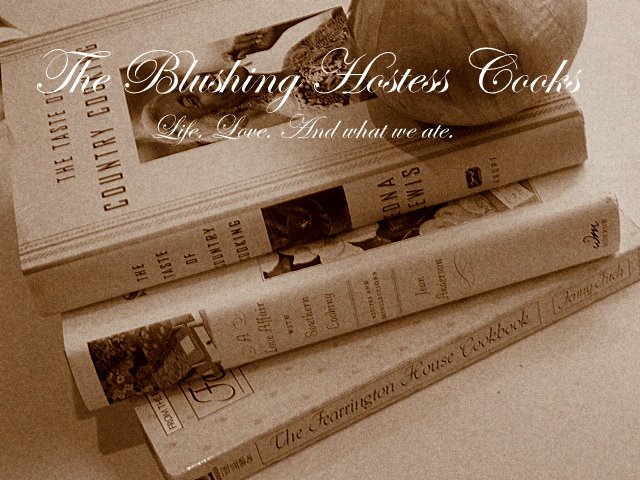Wednesday, January 28, 2009
Monday, January 19, 2009
Baked, crunchy, and change-worthy

Chili chicken egg rolls
Makes 16, 4 servings for a first course, 8 for passed hors oeuvres

You can place a half cup of cup, whathaveyou, of any cooked veggie in this recipe, add more cheese, use sour cream instead of mayo and make any number of changes and still have a great snack or party nibble. Just have more wrappers ready as additions will make more servings. As you can see from the photo, I added left over grilled corn to these and it was delicious. I have served this with jalapeno, lime, Asian chili, and honey mustard sauces all with pleasant results.
These can be frozen before cooking for make-ahead party food.
Cooking spray
1 1/2 cups cooked chicken, chopped
1/2 cup light mayonnaise
1/3 cup shredded cheddar and/or monterey jack cheese
1 - 4-ounce can diced green chilies
1 teaspoon ground cumin
1 teaspoon Goya adobo
1 package egg roll wrappers
Preheat oven to 400 degrees F. Coat a large baking sheet with cooking spray.
In a large bowl, combine chicken, sour cream, cheese, green chiles, adobo, and cumin. Mix well to combine.
Place and individual egg roll wrapper on a flat surface. Place a small amount of filling in the lower third of each wrapper. Fold over the bottom corner of the wrapper and tightly roll up for one turn and then fold in the sides. Dip your finger in water and run it along the corner and edge. Tightly roll up the rest of the way, sealing the edges and seam shut.
Place rolls on the sprayed baking sheet then spray the top of the rolls lightly with cooking spray. Bake 10 to 12 minutes, until golden brown.
Wednesday, January 14, 2009
Lion in Winter
 This is the brilliant, gem-like hue of blood oranges topping a curd made from blood orange and lemon: Winter citrus at its most vibrant and hope-affirming. The glints of brilliance and sparkle in the flesh of a blood orange suggest there is a warming sun and fruit growing somewhere: In places I miss so at this time of year.
This is the brilliant, gem-like hue of blood oranges topping a curd made from blood orange and lemon: Winter citrus at its most vibrant and hope-affirming. The glints of brilliance and sparkle in the flesh of a blood orange suggest there is a warming sun and fruit growing somewhere: In places I miss so at this time of year. I had ideas about trying out another of Simon Hopkinson's recipes with my precious pile of blood oranges but I finally became so fed up with the flavor-issue there that I elected to experiment with blood orange as a curd instead following the recipe I developed for the Lime Curd Tart in September. After dessert has concluded, it is a toss up of those who miss the shortbread crust (me) and everyone else who tried this dessert.
I had ideas about trying out another of Simon Hopkinson's recipes with my precious pile of blood oranges but I finally became so fed up with the flavor-issue there that I elected to experiment with blood orange as a curd instead following the recipe I developed for the Lime Curd Tart in September. After dessert has concluded, it is a toss up of those who miss the shortbread crust (me) and everyone else who tried this dessert.I will try it again with the crust to be sure but I am certain in the meantime that I am recommending to you a cheeky, lively little dessert all on its ruby-twinkling own. I served this with a Blood Orange Caramel Syrup and an almond lace and chocolate cookie. The cookie probably caused my nostalgia for the shortbread crust. The caramel syrup was cloyingly and irritatingly sweet, not worthy of quoting here even for purposes of consuming it over ice cream. Ah, but the curd, the curd is a keeper.
Blood Orange Dessert
Serves 6
adapted from my own tinkering with the genius Lime Curd Tart recipe of these same pages
4 blood oranges at room temperature
Grated zest of two of those same blood oranges
2 tablespoons fresh lemon juice
1 cup sugar
1/4 pound unsalted butter at room temperature
4 large eggs at room temperature
1/8 teaspoon salt

Remove the zest of 2 blood oranges with a microplane. Squeeze the oranges to make 1/2 cup of juice and set the juice aside. In the bowl of an electric mixer fitted with a paddle attachment, cream the butter with the sugar and orange zest. Add the eggs 1 at a time, and then add the orange and lemon juices and salt. Mix until combined.
Pour the mixture into a 2-quart saucepan and cook over low heat, stirring constantly, until thickened, about 10 minutes. The lime curd will thicken at about 175 degrees F, or just below a simmer. Remove from the heat and allow to cool to room temperature. Fill cups with the warm orange curd and refrigerate until set: At least 3 hours though more is best. Serve once set with sweetened whipped cream and fresh blood orange segments made from the remaining oranges.
Monday, January 12, 2009
Indecision
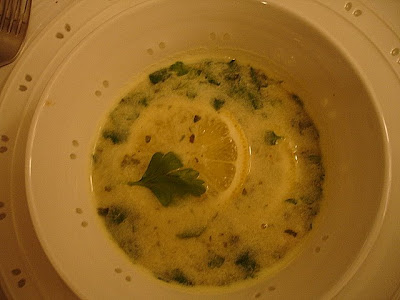
There is the occasional recipe about which I cannot decide: Pass over mentioning it here or chance that it does not appeal to a wide variety of palates, like my own.
As palates go, I like to think mine is educated and broad. This dish did not offend me but I like food to demonstrate flavors of excellence, not a muddiness of chicken, lemon, and parsley, glued together with some cream. I was suspicious of this recipe from the outset because it serves 4, is made with a non-committal stock, bouillon cubes (there are reasons people don't use the stuff any longer), and requires 2/3 cup of cream. When soups include this much tasty fat, warning signs go up that the premise of the base is not flavorful enough. For me, this is one of those soups.
It did not light my winter on fire but in looking over my notes, there will be a lemon-lover who will find this soup a welcome addition to their repertoire, and a person felled by a cold who will appreciate the soothing properties here when made by someone (with several hours kill to make the soup and then to do time with the endless number of kitchen items which need cleaned when the soup is complete) quite well and energetic on their behalf.
The author of the book from whence this recipe springs is reputed to be a world class British chef and to know just everything about fine, simple, British fare. His books in turn are, if the dust jackets are to be believed, highly respected by some people thought highly respectable in the culinary field. Still, I find the flavor of his cooking just not punchy enough on the whole though the book is marvelous for its memoir-like qualities at the top of each chapter and worth owning for, I have concluded, few other reasons. Two of the desserts I have tested have been disappointing (one of them down right preposterous). It has been a long time since I could say I am over a cookbook entirely but, this one is more trouble than it is worth for me from a recipe standpoint, yielding too little flavor than should be derived from all these dish-washing cycles.

Lemon Chicken Soup with Parsley and Cream
adapted from Second Helpings of Roast Chicken and Other Stories, by Simon Hopkinson
Serves 4
I did not love the component of this flavor-base enough to tinker with it for a week. If you are a lemon and chicken soup person who prefers a more flavorful soup, these ideas may help to make a champ of this hopeless middler: Use a really fine, homemade chicken stock, even a double stock, possibly. Rather than pitching all the veg in and stewing them literally to death, consider sauteing them in the pot in a bit of butter, then adding the chicken and warm good stock while omitting the cubes altogether.
12 chicken wings
2 chicken bouillon cubes
2 carrots, peeled and roughly chopped
3 celery stalks, chopped
1 leek, trimmed, sliced, and washed
1 medium onion, peeled and stuck with 3 cloves
1 bay leaf
1 teaspoon thyme
1 small bunch flat leaf parsley, leaves removed and reserved, stalks roughly chopped
1 cup white wine
2 small lemons
Kosher salt and freshly ground pepper
2 tablespoons white rice
2/3 cup heavy cream
Put the chicken wings into a deep pot, add the bouillon cubes and enough water just to cover the wings. Slowly bring to a boil, periodically clearing the scum off the top with a spoon. Reduce the heat to a simmer, continue to skim the surface.
Add the vegetables, parsley stalks, bay, thyme, and the wine. Return to a simmer, skimming the top once again. Turn the heat to low and cook 45 minutes more.
Strain the broth through a sieve and into a clean pot beneath. Allow to settle for 10 minutes. Remove and discard the skin from 6 wings and take the meat from the bone. Chop and put into a small bowl. Set aside. Discard the remaining wings and vegetables. Lift the fat from the surface of the broth with a couple of paper towels and return to the stove. Remove 1 tablespoon lemon zest from the lemon. Add to the broth, taste to adjust seasoning, Add the rice to the broth along with the chopped chicken. Cook for 10 minutes longer. Remove from the heat and allow to cool ten minutes. Meanwhile, juice and strain the lemons.
Puree the soup in a blender in two or three parts with about one third of the parsley leaves and two thirds of the lemon juice until very smooth. Strain with a sieve into another clean pot and return to the stove. Add the cream and the rest of the parsley, finely chopped. Reheat gently over low heat. Taste to adjust seasoning again and add the rest of the lemon juice if you care for it.

Thursday, January 8, 2009
Second Helpings of Parsley Gnocchi in Parmesan Cream
 Here is my lunch. It snowed, sleeted, rained, and hailed all day. Nature railing her worst at us. Because of this bit of environmental temper, all bets were off for my good intentions outside the house. I turned toward a recipe I had planned on taking for a spin for a few days now: Simon Hopkinson's recipe for Parsley Gnocchi in Parsley Soup as published in his second beautifully-written cookbook.
Here is my lunch. It snowed, sleeted, rained, and hailed all day. Nature railing her worst at us. Because of this bit of environmental temper, all bets were off for my good intentions outside the house. I turned toward a recipe I had planned on taking for a spin for a few days now: Simon Hopkinson's recipe for Parsley Gnocchi in Parsley Soup as published in his second beautifully-written cookbook.Let me tell you briefly about this book: It is startlingly well-written and conceived for a cookbook. Half-memoir and half-recipe book, it takes short and painless journeys through a handful of topics and offers three recipes only on each topic. The recipes are short, quick reads and seem quite straight-forward.
While they may be straight-forward, the two-and-a-half I have thus far attempted are long and require a great many steps - and pots. Nothing against the book or the writing which will easily tote you away to the England of Hopkinson's youth. I am only being up-front with you: This stuff will take some time. Carve out a morning or a whole afternoon.
My second recipe attempt which (unwittingly at the outset) also became my third, became so lengthy in time and process, I gave up on making the soup portion of the recipe and proceeded to make Hopkinson's cream sauce from a different gnocchi recipe in order to just finally have done with the thing, as we were all hungry for lunch. It was a pleasant right turn, I am pleased to report. As for the soup, there were so many gnocchi from this dough that we will be dining on the soup for dinner and you shall have the results of that experiment probably before you can even finish loading all the steps in process to this first feat of stove-ery.
In the meantime, should you have a snow day, parsley, cream and some patience for lengthy method, here's your snowy day project.
Parsley Gnocchi in Parmesan Cream
adapted from Second Helping of Roast Chicken, by Simon Hopkinson
Serves 4
If you are also referring to the book, this is a combination of the Parsley Gnocchi in Parsley Soup recipe and the Piedmontese Potato Gnocchi in Parmesan Cream recipe. The method to prepare this dish accompanies the photo tutorial below.
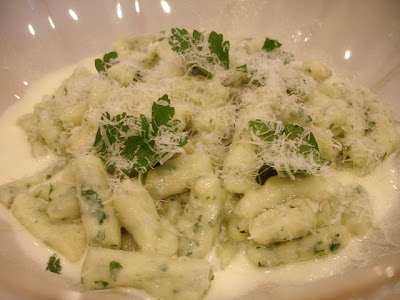 For the Gnocchi:
For the Gnocchi:14 ounces of potatoes, russet or Idaho, peeled
1 egg
1/2 cup parsley leaves, finely minced
1 teaspoon kosher salt
1/2 - 1 cup all purpose flour
For the Parmesan Cream Sauce:
1/2 cup finely grated Parmesan
1 cup heavy cream
1/2 teaspoon kosher salt
 First, steam the peeled potatoes over 1 inch of wildly boiling water (I had little russet potatoes on hand) until a fork easily pierces the center of a potato. Remove the steamer basket and shut the burner off. Place the steamer basket over the burner for a minute to take off a bit of water remaining on the spuds. Remove and set aside momentarily.
First, steam the peeled potatoes over 1 inch of wildly boiling water (I had little russet potatoes on hand) until a fork easily pierces the center of a potato. Remove the steamer basket and shut the burner off. Place the steamer basket over the burner for a minute to take off a bit of water remaining on the spuds. Remove and set aside momentarily. Remove the leaves of the parsley leaves from the stems. Use the stems for something else or discard.
Remove the leaves of the parsley leaves from the stems. Use the stems for something else or discard. Finely mince the leaves on a large cutting board. Leave on the board and spread the leaves out a bit until they form a 10 inch length or so on the board, see below:
Finely mince the leaves on a large cutting board. Leave on the board and spread the leaves out a bit until they form a 10 inch length or so on the board, see below: Now, sprinkle over the kosher salt.
Now, sprinkle over the kosher salt. Place the potatoes in a food mill or ricer and mill until as fine as you are able to get them, allowing the milled potato to fall over the minced parsley and salt on the board.
Place the potatoes in a food mill or ricer and mill until as fine as you are able to get them, allowing the milled potato to fall over the minced parsley and salt on the board. Scoop the remains out of the mill and on to the top of the pile as well. Mash all the remaining pieces to minuscule with a fork until all the potato is softened and no large lumps remain. Continuing to blend with fork, get all evenly combined. Form the batter into a small mound and make a small well in the center:
Scoop the remains out of the mill and on to the top of the pile as well. Mash all the remaining pieces to minuscule with a fork until all the potato is softened and no large lumps remain. Continuing to blend with fork, get all evenly combined. Form the batter into a small mound and make a small well in the center: Break the egg into the mound.
Break the egg into the mound. With a fork, beat the egg soundly inside the well.
With a fork, beat the egg soundly inside the well.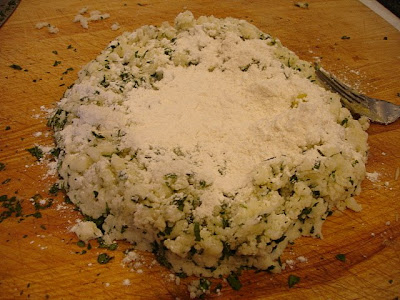 Now sprinkle 1/2 cup flour over the top of all, reserving the remaining to use if you need it to lessen the stickiness of the dough or to flour the board for rolling out the gnocchi.
Now sprinkle 1/2 cup flour over the top of all, reserving the remaining to use if you need it to lessen the stickiness of the dough or to flour the board for rolling out the gnocchi. Beginning with the egg inside and working with a fork at first, then your hands, combine all the ingredients into a dough. It should only be a bit sticky once combined. If it is a little more wet, add and combine one sprinkling of flour at a time, kneading gently, until a dough much like a that for a biscuit is formed.
Beginning with the egg inside and working with a fork at first, then your hands, combine all the ingredients into a dough. It should only be a bit sticky once combined. If it is a little more wet, add and combine one sprinkling of flour at a time, kneading gently, until a dough much like a that for a biscuit is formed.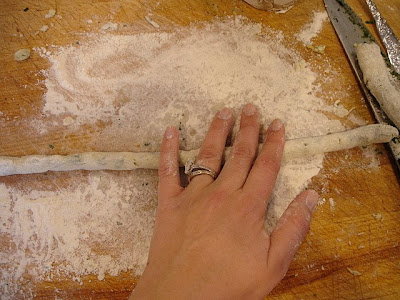 Separate a chunk from the dough mound of about half the size of your palm. Gently dust your board with flour and begin to roll the chunk into a long rope-like cylinder, about 3/4" in circumference.
Separate a chunk from the dough mound of about half the size of your palm. Gently dust your board with flour and begin to roll the chunk into a long rope-like cylinder, about 3/4" in circumference.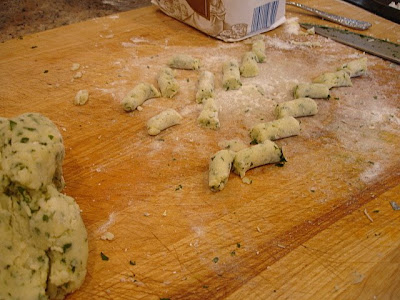 With your knife cut the dough-ropes into 1" lengths.
With your knife cut the dough-ropes into 1" lengths. With a dinner fork, hold a gnocchi at the top of the fork and using your thumb, roll the gnocchi down the length of the fork in order to form a grooved pasta roll.
With a dinner fork, hold a gnocchi at the top of the fork and using your thumb, roll the gnocchi down the length of the fork in order to form a grooved pasta roll. As each is finished, place them on a flour dusted sheet pan. Repeat the roll/ cut/ fork process with all the remaining dough. Allow the pasta to rest at room temperature for at least an hour though longer would be best.
As each is finished, place them on a flour dusted sheet pan. Repeat the roll/ cut/ fork process with all the remaining dough. Allow the pasta to rest at room temperature for at least an hour though longer would be best.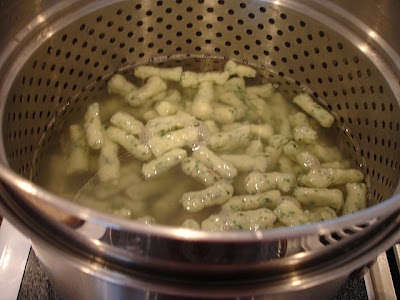 When ready to cook, bring a large pot of water to boil with a bit of salt. Gently drop all the gnocchi into the pot, trying not to also pitch in the flour from the pan. Some of the pieces will rise to the top right away. Be patient, you need all of the pasta to rise to the top as below and once they do you must cook for 30 seconds longer:
When ready to cook, bring a large pot of water to boil with a bit of salt. Gently drop all the gnocchi into the pot, trying not to also pitch in the flour from the pan. Some of the pieces will rise to the top right away. Be patient, you need all of the pasta to rise to the top as below and once they do you must cook for 30 seconds longer:
Your pot should look like the above with all the pasta at the top, then cook half a minute more. This will not take long: maybe two or three minutes in total. Remove the pasta from the water.
 Meanwhile, into a small sauce pan, place the cream, Parmesan, and salt. Stirring occasionally, allow to heat until the Parmesan melts and steam rises from the surface. Do not boil.
Meanwhile, into a small sauce pan, place the cream, Parmesan, and salt. Stirring occasionally, allow to heat until the Parmesan melts and steam rises from the surface. Do not boil.  Place the pasta in a bowl and pour the Parmesan cream over. Garnish with fresh parsley leaves, grated Parmesan, and/or a little gray salt, depending on your tastes.
Place the pasta in a bowl and pour the Parmesan cream over. Garnish with fresh parsley leaves, grated Parmesan, and/or a little gray salt, depending on your tastes.
Tuesday, January 6, 2009
Dear Blushing Hostess, Please be assured...

As I mentioned, Chums, I isolated two highly lovable products over the holiday season and was unable to point one out to you because you would think I was some sort of daft cow living in a mental fictional ice-cream flavor wasteland because the corporate site failed to take ownership of the ice cream flavor about which I am so jazzed. It still does not. But, here I have proof in writing that I am not sending you postcards from the tea party in the rabbit hole...
Dear Blushing Hostess,
Thank you for your email regarding HÄAGEN-DAZS® Caramelized Pear & Toasted Pecan Ice Cream. We appreciate the time you have taken to pass your comments on to us.
Please be assured that we are manufacturing this flavor. Your comments have been forwarded to our Web Team.
We at HÄAGEN-DAZS® Ice Cream appreciate your interest in our company and our products. We value our consumers and we thank you for the opportunity to respond to your concerns.
Sincerely,
Nicole
There you have it. Caramelized Pear and Toasted Pecan Ice Cream. We located it locally in Westchester. You may be in luck and spot it at the grocer too. If not, you are up a creek without a float as the website will leave you wanting. Right, dead horse... okay, moving on.
Now, here is what you can do: Take your slices of cake, say, Breton Butter Cake, Greek New Years Cake, all manner of vanilla butter cake iced or otherwise, and serve it with this ice cream and my brown sugar sauce. I also like to throw some chopped candied pecans over the top. It becomes quite a decadent treat and it is an unexpected burst of pear and pecan when the cake is a quiet buttery solider and everyone thinks you've hauled out the vanilla cake with vanilla ice cream - ah, stop! I would never do that.
So, here it is then. Little effort for a hugely grand dessert sauce, the sort they once made at home in the blink of an eye but no longer. For what excuse, I'll never know.
Brown Sugar Sauce
Serves 8
When this sauce is made instead with light brown sugar, they call it butterscotch. You could do that too. And you sprinkle a bit of Fleur de Sel over as well. No telling what you might think of now that the ease of this dandy is placed in your hands.
1/3 cup corn syrup
5/8 cup brown sugar
2 tablespoons butter
1/8 teaspoon kosher salt
1/3 cup heavy cream
In a small sauce pan over medium heat, place corn syrup, brown sugar, butter, and salt. Bring to a boil and watching constantly, allow to boil until it reaches the consistency of a heavy syrup. Remove from the heat. Allow to cool fifteen minutes, stirring occasionally to allow the heat to escape and facilitate cooling. Add the cream and whisk in quickly. Serve. Can be very gently reheated over low heat more than once if needed.
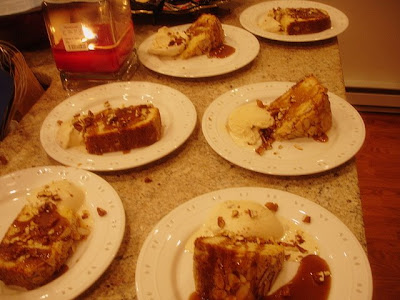
Sunday, January 4, 2009
Heretical Suggestion #2
Moving on, I think the world of a new mixer made by Canada Dry (no, indeed, the Hostess is not paid to mention products, in fact, she pays to enjoy them!) called Green Tea Ginger Ale, but not with any intention of using said product as a cocktail mixer. I think it would muddle a cocktail unforgivably though it is fantastically tasty. Rather, I see it as a potentially new and sprightly punch sensation.

Charleston Receipts. To my mind, the preeminent Junior League cookbook is as iconic for its status as a chronicle of both historical Low Country food ways over two centuries as for its position as keeper of all the once-secret recipes of generations of well-known Charleston hostesses, their family names nearly as iconic in that fair city as the book itself. In recipes dating as far back as 1890 or possibly even earlier (things can sometimes get a bit murky in the recording, for example: "... as served at the Club's last dance some years ago", this book was first published in 1950, it is hard to say how old some old recipes are...) and making up to 650 servings (I kid you not), green tea is included as an ingredient in no fewer than seven punch recipes:
St. Cecilia Punch
Charleston Light Dragoon Punch
Otranto Club Punch
Cotillion Club Punch
Champagne Punch
Regent's Punch
Frost Punch
Green tea of the sweetened Lipton bottled drink is not what these recipes are after. Keep in mind; this was 1890, in some cases. No, more like freshly brewed and cooled actual green tea. But - and here is where my old pal Libby (of the finest Charleston stock) calls and threatens to confiscate my copy of Charleston Receipts again, having lost her patience "for good, this time, you heretic.", after the Red Velvet Cake recipe posted herein... I am just saying if one were to swap in the Green Tea Ginger Ale for the gun powder green or green tea... Who knows, it could lead to merriment in Charleston all over again. One should just be careful to call their creation by another moniker so as not to muck up the accuracy of these recipes to their given local names, or Libby will have both our heads.
